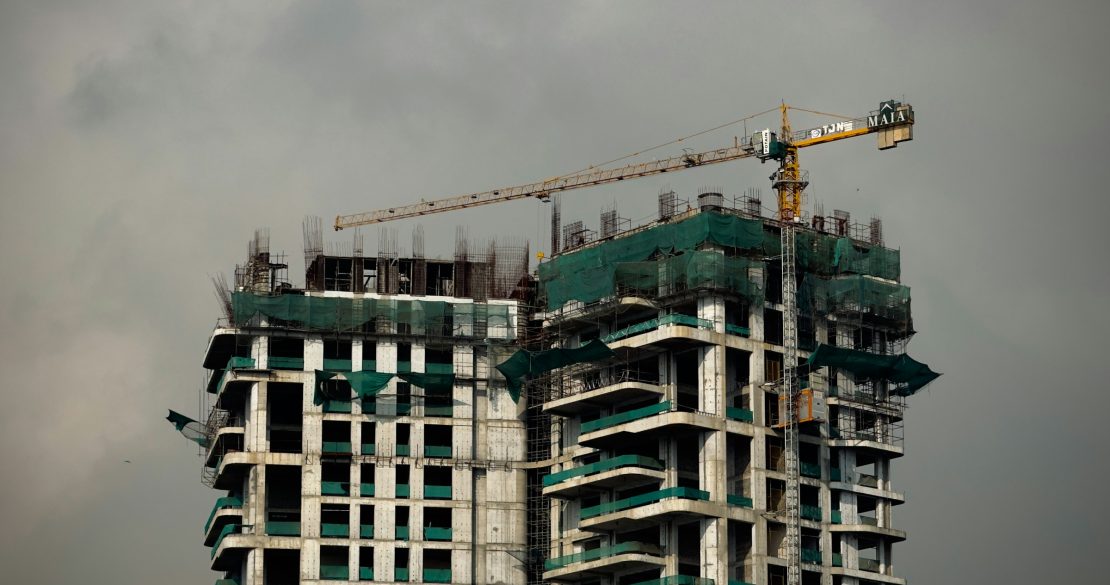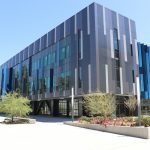What goes into building? Finding the perfect property, preparing that property, drawing up plans, gathering permits, employing the right contractor and subcontractors, and finally getting started, right?
Hold on, wait a minute. There’s a lot more than that! You need to ask yourself what materials do you want to build with, too. Every building material and method leaves its mark on the environment. Whenever you use wood as part of your project, it depletes trees in the forest used for making the beams, then there’s the energy it takes to go from tree in the forest to the finished beams on your site. It may take a while for those trees to grow back. But your building is constructed with steel, not wood. The process of creating a steel beam creates a carbon footprint, too in the materials, practices, and resulting production waste. There are certain materials that lower this impact and make your home a contributor to the sustainable building movement.
This is a general list of sustainable building materials, which maybe used for the construction of the building itself, or for interior finishes. Structr Group can help you choose the best sustainable materials to use for your project’s needs and goals.
Table of Contents
Bamboo
Recycled Steel
Reclaimed Wood
Cork
Recycled Plastic
Green (Living) Roofs
Mud Brick (Adobe)
Recycled Glass
Low-VOC Paint
Solar Tiles
Earth Bags
Timbercrete
Papercrete
Plant-Based Polyurethane Rigid Foam
Mycelium
Hempcrete
Sheep’s Wool
Ferrock
Rammed Earth
Straw Bales
Final Thoughts
Bamboo
No matter how you use wood in your building, it needs to be harvest and processed. Pine is a popular choice, but depending on the species, it grows back at a rate of just 1-3 feet per year. Douglas fir, which grows at a rate of three feet per year, is a popular choice.
When you use wood for aesthetic purposes, consider bamboo. It’s different look draws the eye, and the bonus for you is its sustainability. Bamboo has a growth rate of up to one meter (3.3 feet) per day! That’s over 1,200 feet in a year. Due to this rapid regeneration rate, there’s no fear of deforestation in the way there is with other woods. Raw bamboo attracts insects and fungus.

While building with bamboo on a large scale is still unachievable, studies have shown that buildings four stories or smaller can be constructed with treated bamboo. This treatment increases durability and longevity and assists in moisture resistance, insect infestation, and decay prevention. Bamboo used in construction is typically only found in tropical regions, meaning using it anywhere else in the world includes transportation, sometimes on a global scale. That adds a higher carbon footprint that offsets its overall environmental benefits. Don’t let these cons scare you; bamboo is an overall positive when it comes to sustainable construction practices.
Recycled Steel
Just about any time “recycled” is used in a sentence, the word “sustainable” is also fairly close by. Steel from old buildings and scrap metal can be processed and used in new builds to help reduce the carbon footprint caused by the manufacture of new steel. Eco-conscious building owners and developers will be happy to hear that recycled steel uses 60-75% less energy than the fabrication of brand-new beams. But the creation of recycled material, and especially steel, isn’t without some challenge. Although still being lower-energy than new steel production, the recycling process itself requires a significant amount of energy.
Reclaimed Wood
Much like the word “recycled,” the word “reclaimed” also triggers automatic thoughts of Eco-friendly building practices. Check out nearly every home design show on HGTV to see how reclaimed wood is used for indoor décor or part of a structure.
The benefits: reusing wood decreases the demand for new lumber, thus cutting down carbon emissions associated with the logging and transportation of new wood. It also boosts forest conservation. Additionally, its unique aesthetic reflects its history. When used in décor, it sparks interest and conversation.
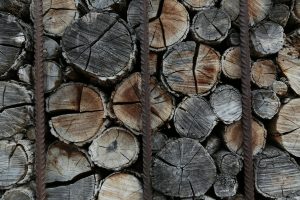
Using reclaimed wood for interior structures and designs isn’t as easy as just finding a piece of wood you like. The availability of quality reclaimed timber is limited. It requires careful handling since it may have nails, screws, and sharp edges or have been treated with potentially harmful chemicals that have no place in sustainable building materials.
Cork
Your knowledge and use of cork may begin and end at the cork board you use in your home or office to post important reminders. The material is primarily sourced from the bark of the cork oak tree. The best part: its harvesting doesn’t harm the tree one bit! The bark will regenerate over time, making it a highly renewable material next to bamboo.
The process also helps carbon sequestration since cork oat trees store more carbon to aid in the regeneration process. Other benefits of cork include thermal and acoustic natural insulation properties. Consider it for flooring, wall covering, or underlayment. Cork is lightweight and resistant to mold, mildew, and water – three things you don’t want in your building.

Still, there are some things that may shy you away from cork. It’s very susceptible to physical damage like scratches, dents, and fading in direct sunlight. While it makes the list of sustainable production methods, most cork is sourced from the Mediterranean, with transportation adding to the carbon footprint.
Helpful definition: Carbon sequestration is the process of storing carbon in a “carbon pool,” thus limiting the release of carbon dioxide into the atmosphere.
Recycled Plastic
Do you ever wonder what happens to the plastic containers you toss in your recycling bin? The simple answer is they head to your local recycling plant, where they may be turned into more containers – and even building materials. Recycled plastic is increasing in popularity given its essential part in keeping plastics out of oceans and landfills and making the world a better place.
Some of the pros that may attract you to building with recycled plastic: high durability, and resistance to issues like corrosion, rot, and pests. Recycled plastic reduces the need to produce new plastics – a very energy-intensive process full of carbon emissions.
Another concern is the strength and structural integrity of recycled plastic can vary, making it an unsuitable material for some load-bearing applications. Also, plastic recycling is a more complex and costly recycling methods.
Green (Living) Roofs
When it comes to sustainability in your building, look up! Office buildings often have mechanical needs on the rooftop, but buildings that want to add some sustainability can add some of that sustainability to the rooftop, too.
Green, or living roofs are one of the fastest-growing trends in sustainable building practices today. By growing vegetation, the roof absorbs pollutants, reduces heating and cooling costs – since the soil needed acts as a natural insulator, and more. A green roof is also great for stormwater management, since the roof absorbs and filters the rainwater, reducing runoff and extra strain on your building’s drainage system; a benefit for buildings in both rural and urban environments.

Decide what you want your green roof to be. It could be a variety of plants, grasses, flowers, and the like, or you could even install a rooftop garden that produces fruits and vegetables. A rooftop garden full of produce can be used for providing healthy options in the break room, or give your business the opportunity to donate fresh, healthy food to local food banks.
However, the startup of a green roof requires significant initial investment, including a robust structural support system, and regular care and maintenance for the vegetation you choose to install.
Mud Brick (Adobe)
Mud brick, or Adobe, is one of the oldest building materials around, and it’s sustainable. Bricks are formed from a mixture of earth, water, and organic materials like straw and are sun-dried rather than fired. This natural engineering process offers a significant reduction in energy consumption and carbon emissions when compared to brick manufacturing.
Benefits for your structure include nearly unmatched thermal mass, which regulates indoor temperatures – occupants of adobe buildings enjoy an indoor environment that’s warm in the winter and cool in the summer. This attribute alone requires less reliance on artificial heating and cooling systems for increased energy efficiency.
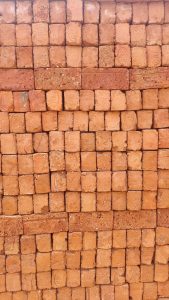
You’ll want to consider your climate and environment before choosing Adobe. It is less durable in wet climates, requiring regular maintenance to prevent erosion. Structures built with Adobe bricks are also more prone to seismic damage without the proper reinforcement.
Recycled Glass
All recycled materials have Eco-friendliness built in! Recycled glass is made by repurposing glass waste, which keeps the material out of landfills. Like recycled steel, recycled glass takes significantly less energy and carbon emissions to produce than does the manufacturing of new glass.
Recycled glass is durable, easy to maintain, and can be used in a variety of applications such as countertops, tiles, and other decorative elements that will make your building unique. Recycled glass makes the perfect sustainable material for indoor and outdoor use. Much like with recycled steel, note that the cost of glass recycling is high, and while you may feel you must include recycled glass in your build, it can be more expensive than new glass.
Innovative Materials for Sustainable Home Building
There are a number of other sustainable materials you may not know about or have considered as a building material for your next project. For our clients hoping to add some unique touches to their sustainable buildings, we can discuss these materials as well.
Low-VOC Paint
Volatile organic compounds, or VOCs, are organic compounds with high vapor pressure at room temperature. VOCs are emitted as gases from various chemicals, such as those found in traditional paint. To lower your building’s environmental impact and raise its sustainability, using paints with low levels of VOCs minimizes the amount of these chemical pollutants and improves indoor air quality, too.

Low VOC paints often have reduced odor as well, and are available in a variety of colors, shades, and finishes to achieve your perfect color palate. As with many of the sustainable building materials on this list, low-VOC paint can be more expensive, and long-term costs, durability, and coverage may not match those of higher VOC paints.
Solar Tiles
Along with a living roof, installing solar panels atop a building has also been a way to achieve building sustainability. Going solar has been a method that has survived decades. It seems a drive through any neighborhood in the U.S. will net you multiple sightings of homes with solar panels, and many office buildings and complexes show their commitment to solar with rooftop arrays and even on covered parking.
Solar tiles, however, are different. Much like the roofing tiles on most homes today, solar tiles blend traditional roofing material with solar panel technology. Add to you building’s sustainability power when you harness the power of the sun to generate electricity for your building without the bulkiness of large conventional solar panels. You’ll reduce your need for fossil fuels and cut down on greenhouse gas emissions while you’re at it. In addition to their ability to generate clean energy, they also offer the protective qualities of traditional roofing tiles.
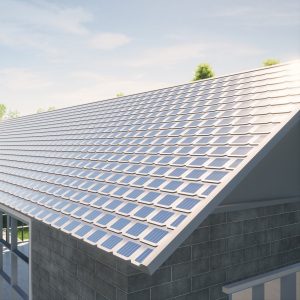
Like any product outside the norm, cost is a big consideration. Solar tiles are often more expensive than traditional solar panels and have lower efficiency rates than panels. Like panels, the initial investment can be significant. Solar tiles, no matter how much you want to include them, will not be suitable for all roof types, so consider your building materials carefully.
Earth Bags
This unique building material is made from polypropylene bags packed with earthen materials, including soil, sand, and clay. Much like Adobe bricks, earth bags are Eco-friendly due to their utilization of natural, locally-sourced materials. Not only is the carbon footprint of manufacturing earth bags significantly less, so is the means to transport them to the building site. Earth bags offer excellent thermal mass for the all-important “warm in the winter, cool in the summer” indoor temperature, without reliance on artificial heating and cooling methods.
Using earth bags takes careful planning and requires significant physical effort and time, and aren’t necessarily right for your building. The team at Structr Group can help you create the proper design and help implement proper construction techniques to ensure the structural integrity of your building using earth bags and battle against moisture – a big concern in humid and rainy climates.
Timbercrete
Sustainability is construction isn’t just about using natural products or recycled products. It’s about using the whole product. While recycling plastic, glass, and steel, or turning to materials like Adobe or earth bags for their use of natural products goes a long way toward sustainability, using every piece – even what seems like waste – of a product is also sustainable. That’s what timbercrete does. It is a composite building material made from sawdust, a waste product from the timber industry, and concrete. Using the sawdust keeps it out of landfills and makes use of a resource that’s readily available on just about every construction site. Timbercrete and its use of sawdust cuts down on the need for cement, a product with a high carbon footprint during production.
You can add these characteristics to the plus column, too: timbercrete improves insulation properties when compared to traditional concrete, adding to the energy efficiency of your building. It’s also lighter than standard concrete, meaning a reduction of transportation emissions and easier handling during the construction process.
Some cons: while a unique alternative to traditional concrete, timbercrete may offer lower structural strength, limiting its use in various load-bearing applications or requiring a larger quantity for the same structural efficiency. As with other newer materials, availability may be scarce, resulting in higher up front costs.
Papercrete
We’ve been recycling paper since elementary school. The tall boxes standing in the corner of the classroom waiting to hold messy first drafts of essays or the test you didn’t do as well on as you thought you would. Printed newspapers are almost a thing of the past, but your credit card statement, water bill, and more are often still printed and mailed to your home each month. All that paper goes into the recycling bin once it’s no longer needed. When it gets to the recycling facility, the paper is ground up and processed into other forms to be used again. The water bill you threw out last year may come back in the form of papercrete.
Papercrete is an innovative and sustainable material that is a mix of recycled paper, cement, and additional fibers or additives to strengthen it even more. The recycled paper, along with a smaller carbon footprint and reduced reliance on landfills, conserves energy. Like timbercrete, papercrete is more lightweight, easier to handle and work with, and offers excellent insulation properties for your next build, all keys to supreme energy efficiency and sustainability. Don’t forget that the use of recycled paper makes it a more Eco-friendly choice over conventional concrete. Ask the team at Structr Group how to implement papercrete into your next build!
Also like timbercrete, papercrete faces the same strength and durability challenges compared to traditional concrete. You’ll need to consider adding additional support for various load-bearing purposes if you’re set on using it as part of your building’s structural elements. The paper in papercrete may also be more susceptible to moisture absorption and extra sealants and design considerations need to be made to prevent degradation.
Hempcrete
This sustainable composite building material is made from a mixture of hemp fibers, water, and lime. Similar to bamboo, hemp is a fast-growing, low-impact crop that requires minimal pesticides, fertilizers, and other harmful chemicals. Its Eco-friendliness extends to its ability to absorb a significant amount of carbon dioxide during growth – that makes it a carbon-negative material!
Like many of the materials on this list, hempcrete offers highly impressive insulating properties on the thermal and acoustic levels. This quality helps reduce heating and cooling energy costs, and hempcrete’s breathability regulates humidity for a healthier indoor environment. Other attributes in the pro column for hempcrete include fire-resistance, being lightweight, and pest-resistance.
Consider everything before you move forward, however. The material’s lower structural strength compared to traditional concrete negates its use for load-bearing walls and insulation. Also, certain regions have strict hemp cultivation laws, meaning sourcing can be costly. It may not be the best option for your large-scale building.
Plant-Based Polyurethane Rigid Foam
This innovative and Eco-friendly building material is derived from other renewable resources, such as bamboo, kelp, and hemp. This plant-based alternative already has a leg up on its petrochemical counterpart: it reduces the reliance on fossil fuels and the associated carbon footprint that reliance produces. The production of plant-based polyurethane rigid foam uses less toxic chemicals, too, further adding to its place as more Eco-friendly.
Like many other materials on this list, you can add this building material to the column with excellent insulation properties and energy efficiency. Along with being lightweight and durable, it provides impressive thermal and acoustic insulation to reduce artificial heating and cooling needs. With even more positive attributes like resistance to moisture and mold, and it makes the perfect construction material for certain areas of your build. As with most newer building technologies, the cost is typically higher than its established counterpart and may not be as readily available in all regions.
Mycelium
There are a number of materials on this list you may not have even thought could be building materials. Mycelium, for example. It’s the root structure of fungi and is currently one of the most groundbreaking Eco-friendly building materials on this list.
The sustainability of mycelium lies in its natural composition and low-impact process of cultivation. Much like bamboo, mycelium grows quickly. It also feeds on agriculture byproducts, including sawdust and straw, thus turning this waste into a valuable, usable resource on any construction site. The pro column continues to fill with reasons including less water consumption and energy use than traditional building material manufacture; it biodegrades for a minimal environmental impact, and, like many other entries on this list, is an excellent choice for sustainable insulation. Mycelium can be grown into various shapes and sizes for design versatility like no other, and to top it all off, it is also fire-resistant.

Innovation takes time. Mycelium is still in its early stages as a building material, in both home-building and your building’s construction, and there is limited data on its long-term durability and performance. Additionally, careful installation and maintenance are also required to prevent its susceptibility to moisture.
Sheep’s Wool
The wool in your sweater may be the next big step in sustainable building materials. Sheep’s wool is quickly gaining recognition in the Eco-friendly building material market, with its current main use as insulation. The natural, renewable resource (sheep regrow their wool annually) is one of the most sustainable items on this list.
Harvesting it has a minimal environmental impact when compared to synthetic alternatives. Add up the pros and you may pivot to sheep’s wool as your insulator of choice on your next build. If you own a wool sweater, you know it has excellent thermal properties. Those properties extend to building material and add to the excellent regulation of indoor temperature and efficiently. The natural fibers are breathable and allow for moisture control and a healthier environment. Remember what that means? Increased well-being for occupants, and high productivity. Rounding out the list, wool is naturally fire-resistant and can absorb indoor air pollutants, too.

Many of the items on this list are fairly more costly than their conventional counterparts, with wool being no exception. Some of its expense comes from the necessity to add extra treatments during manufacture to deter pests and enhance longevity and overall performance.
Ferrock
Cut down on industrial waste and take carbon dioxide out of the environment, just with the building materials you choose for your next build. Ferrock is a fairly new building material, innovative in its use of waste steel dust and silica from ground glass. It is considered a more sustainable alternative to traditional concrete and reportedly stronger than standard Portland cement. Another check in the plus column is it absorbs carbon dioxide, making it an ideal option when it comes to battling climate change.
However, its infancy status means ferrock isn’t as readily available or as thoroughly tested as traditional concrete, like many of the other materials on this list. Add on the complex production process requiring specific conditions and you may be looking at increased time and monetary budget up front to benefit in the long-term.
Rammed Earth
Rammed earth is an ancient building technique that has sustainability written all over it, just like adobe bricks. The process involves compacting layers of earth with other natural stabilizers like lime and/or cement. Add another check to the Eco-friendliness attributes of rammed earth: it uses local soil. Sourcing local materials cuts down on the need to transport traditional construction materials and the carbon emissions that process creates. The technique also saves energy consumption when compared to conventual construction materials.
We could sing even more praises, like excellent thermal mass, sound insulation, durability, and a unique aesthetic from its natural, textured layers. When you consult with Structr Group for your next build, we can talk about how this building material fits in with your plans and goals.
Consider your costs and time frame before choosing rammed earth. It requires highly-skilled labor and meticulous execution to get things right, adding more time and cost than more traditional construction methods. Additionally, regions with high rainfall or seismic activity will need additional reinforcement to combat those conditions.
Straw Bales
Straw bales, a byproduct of grain production, are emerging as an Eco-friendly alternative in the building materials space. It’s another way to incorporate waste products into making something new, keeping waste out of landfills and turning agricultural residue into a valuable building resource. While it’s not particularly cost-effective for the shell of laarge-scale buildings, it’s a material to consider for other uses.
Like many of the materials on this list, straw is a renewable resource that also captures carbon during its growth, creating a lower carbon footprint than other traditional building materials. Straw is another item on this list that comes with excellent insulation abilities, reducing the reliance on artificial heating and cooling and related costs. If your building is in or close to agricultural regions, the material is easy to source. If you’re looking for natural, rustic charm in parts of your build, straw’s unique aesthetic will help you accomplish your goals.
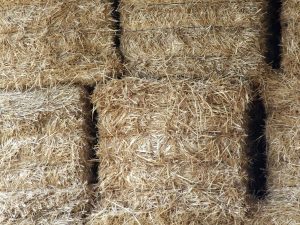
There are, of course, drawbacks to consider. Take into account your environment and its limitations before choosing straw bales. The bales need to be kept dry, or treated to prevent mold and rot. It is a rather labor-intensive process, too. Using straw bales may require thicker walls compared to conventional materials, cutting down on interior space on smaller lots.
Final Thoughts
We at Structr Group know there’s an optimal building vision for every client, and we want to help you design it to your custom needs. If sustainability and low environmental impact is also a part of your plans, we can walk you through many options.
The materials discussed in this article are just some of your options. Book an appointment with us to discuss all of your options and start building.
Contact us today!


